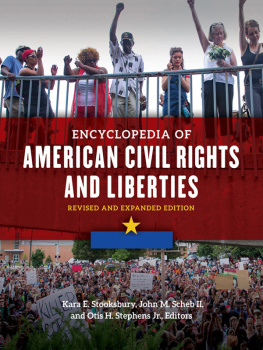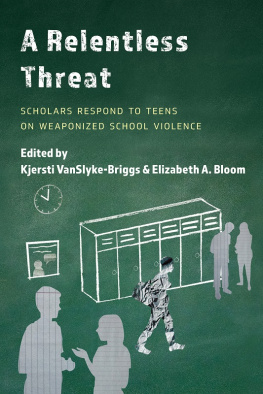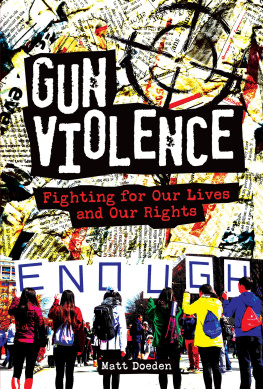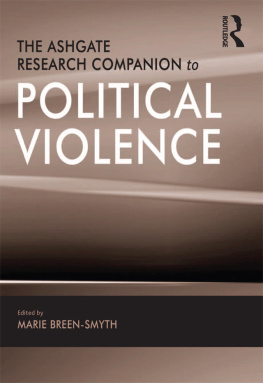Violence in American Society

An Encyclopedia of Trends, Problems, and Perspectives
VOLUME 1: Animal Cruelty to Murder
VOLUME 2: Police Violence to Youth Violence
Chris Richardson, Editor

Copyright 2020 by ABC-CLIO, LLC
All rights reserved. No part of this publication may be reproduced, stored in a retrieval system, or transmitted, in any form or by any means, electronic, mechanical, photocopying, recording, or otherwise, except for the inclusion of brief quotations in a review, without prior permission in writing from the publisher.
Library of Congress Cataloging-in-Publication Data
Names: Richardson, Chris, 1985 editor.
Title: Violence in American society : an encyclopedia of trends, problems, and perspectives / Chris Richardson, editor.
Description: Santa Barbara : ABC-CLIO, an Imprint of ABC-CLIO, LLC, [2020] | Includes bibliographical references and index. | Contents: volume 1. Animal cruelty to murder volume 2. Police violence to youth violence.
Identifiers: LCCN 2019037389 (print) | LCCN 2019037390 (ebook) | ISBN 9781440854675 (set) | ISBN 9781440854699 (vol. 1) | ISBN 9781440854705 (vol. 2) | ISBN 9781440854682 (ebook)
Subjects: LCSH: ViolenceUnited StatesEncyclopedias. | Violent crimesUnited StatesEncyclopedias.
Classification: LCC HN90.V5 V5485 2020 (print) | LCC HN90.V5 (ebook) | DDC 303.6097303dc23
LC record available at https://lccn.loc.gov/2019037389
LC ebook record available at https://lccn.loc.gov/2019037390
ISBN: 978-1-4408-5467-5 (set)
978-1-4408-5469-9 (vol. 1)
978-1-4408-5470-5 (vol. 2)
978-1-4408-5468-2 (ebook)
24 23 22 21 201 2 3 4 5
This book is also available as an eBook.
ABC-CLIO
An Imprint of ABC-CLIO, LLC
ABC-CLIO, LLC
147 Castilian Drive
Santa Barbara, California 93117
www.abc-clio.com
This book is printed on acid-free paper 
Manufactured in the United States of America
Contents
Stephen Muzzatti and Kirsten L. Grieve
Rhena South
David White
Andrea Simmonds
Tamar Faber
Sabine Elisabeth Aretz
Dana Mihilescu
Jennifer Potter
Angie Chuang
Aaron Drummond and James D. Sauer
Chris Richardson
Nataleah Hunter-Young
Grant Tietjen
Luigi Esposito
Kendall Marchman
Aaron Puhrmann, Christian Schlaerth, Justin Jacobi, and Garrett Gillen
Walter Isaac
Shaughan A. Keaton and Christopher C. Gearhart
Sabine Elisabeth Aretz
Ryan Shaffer
Jody B. Cutler-Bittner
Glen M. E. Duerr
Karen J. Renner
Acknowledgments
This work has benefited from the thoughtful contributions of many dedicated scholars. In addition to those mentioned at the end of this collection, I would like to thank two research assistants, Nicole Jordan and Trina Duncan, without whose help and dedication as undergraduate students in the Communication Studies Department at Young Harris College this publication would never have been completed. And thank you to Claudie Massicotte, who has pushed me to recognize and resist subtle and systemic forms of violence for a decade now.
A NOTE ON CONTENT
This text focuses on violence. As a result, many of the entries and primary documents may contain language or descriptions of violent acts that may make readers uncomfortable. We have chosen to retain this content, as to omit uncomfortable language or censor historical events is to deny the reader the chance to understand and confront these events deeply and honestly.
Introduction
The ultimate weakness of violence is that it is a descending spiral, begetting the very thing it seeks to destroy. Instead of diminishing evil, it multiplies it. Through violence you may murder the liar, but you cannot murder the lie, nor establish the truth. (King Jr. 2010, 64)
Violence was not invented by the United States. But it has assumed uniquely American characteristics over the last few centuries. With heated debates about the Second Amendment, the popularity of Hollywood action films, aggressive lobbying from groups such as the National Rifle Association (NRA), and a military budget equal to the next seven largest countries combined, the United States is conspicuous among nations when it comes to violence.
There are more guns in the United States than people (Ingraham 2018). To the admiration and chagrin of many local populations, 1.3 million American troops are stationed around the world (Brown and Gould 2017), while 2.3 million people are in the custody of the American criminal justice systemalbeit most for nonviolent crimes (Sawyer and Wagner 2019). Action heroes from John Wayne and Clint Eastwood to Arnold Schwarzenegger and Scarlett Johansson can be seen battling in cinemas and living rooms any day of the week. On college campuses, more than one in five female undergraduates experience sexual attacks (Association of American Universities 2015). And race relations continue to strain, having gone from legal slavery during the formation of U.S. colonies to Jim Crow subjugation after the Thirteenth Amendment to contemporary social movements such as #BlackLivesMatter that call for an end to police brutality against people of color.
At the same time, however, the rate of violent crime in the country has been dropping precipitously since the early 1990s. On average, less than 1 in 100 people fall victim to violent crime in a given year, and most people will live their entire lives without such experiences (FBI 2017). While dramatic tough-on-crime politicians and tragic coverage of the relatively rare cases of severe stranger violence seem to hold the lions share of news and public attention, most acts of violence in the country are far less blatant and involve bruises, psychological trauma, and the denial of human dignity that often go unnoticed by the mainstream media as well as much of the population.
The history of violence in the United States remains contested. Having been founded by people escaping persecution and violence in their countries of origin, it is perhaps ironic that the United States quickly acquired a history of violence of its own. Many activists call for acknowledgment and reparations for the violence inflicted on First Nations peoples, slaves, and many working-class groups during the European exploration of the New World. At the same time, schools in Texas came under fire in 2015 for referring to the immigration of Africans between 1500 and 1800 to southern United States to work on agricultural plantations (Wang 2015). Such whitewashing of a violent past marks the American story significantly. It would seem that the only thing historians, political leaders, social activists, and talk show hosts can agree on is that America has never been without violencethough the perpetrators and reasons will forever be disputed.
There is no consensus on the causes, current dimensions, and solutions to violence in this country. However, the contributors to this encyclopedia diligently outline the major events, research, and representations in order to shed light on the debates and provide a basis for discussion that acknowledges the various and often conflicting ways violence affects the people of America. Looking to historical and contemporary sources, these experts highlight the various responses we have seen in relation to legal, cultural, political, and personal challenges.
Arranged alphabetically from Animal Cruelty to Youth Violence, these 23 entries provide a wide lens through which readers can make connections and better understand the intricacies of the major themes and subject matter. Each entry provides Historical Dimensions that generally begin with the founding of the country in the eighteenth century and end at the turn of the new millennium. Current Dimensions consist of twenty-first-century problems and responses, often considering accelerated technologies, big data, and the contemporary political landscape. Entries also feature a section of Media Depictions that explore the way violence has appeared in major media from magazines and broadcast news to popular music and video games. In the Primary Documents sections, contributors have provided important textual excerpts from major legal cases, government agencies, as well as correspondence from important political actors of the last centuries to give researchers a starting point from which they may further investigate such archival materials.
Next page











